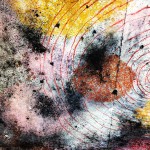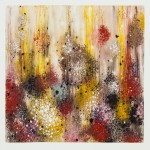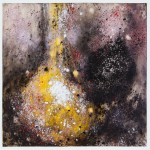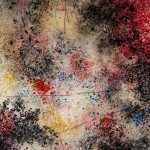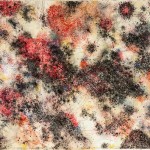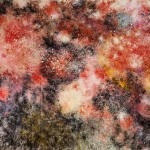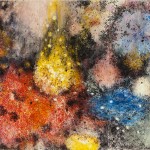I thought of a labyrinth of labyrinths, of one sinuous spreading labyrinth that would encompass the past and the future and in some way involve the stars. – Jorge Louis Borges
Dana Velan’s latest series, Nebula, features mostly large-scale drawings on Mylar. Their appeal is as palpable as it is visual. To stand before them is to be drawn into a strangely resonant sanctum cum universe.
We must imagine the artist’s process as she works the Mylar skeins, covering the translucent surface with intricate repetitive marks, obsessively laid down with the fine sharpened edge of an oil stick. On such an expanse of surface, how much easier to paint with a brush. But no. The hermetic marks are laden, scrumbled, sanded to transparency only to be redrawn again. There are no grand strokes, no sweeping heroic gestures. Rather, the artist builds up the oval and circular shapes, slowly, in paced time. The viscous oil accumulates, overlaying forms and clusters that seem to emerge from deep space, explode towards us or, alternately, fall inexorably at our feet.
Seen in the context of Velan’s overall oeuvre, Nebula presents a further iteration of a recurring theme – the quest for belonging. These latest manifestations are but a reconsideration of how we might feel at home in the world. “I want to investigate how I move through this time and space, and how … I define and redefine myself in terms of all I can imagine.”
The quest for a place to call home has been a focus of the artist’s for over three decades. If the issue of diaspora lies at the heart of our post-modern world, Velan’s work can be situated within that discourse. Severed from her homeland (Czechoslovakia) abruptly and traumatically in 1968, she was to return only 15 years later but never again to live. Velan has visually pursued the theme of belonging through a complex of signifiers, beginning with metaphors of enclosure, protection and shelter. Through the 80s and 90s she drew images of womb-like nests, hearths and dwellings, several of which led our gaze into cavernous black openings. One recalls Gaston Bachelard’s description of the oneiric function of such depth structures and their vital relation to reverie and the poetic imagination. Velan recreates variations of the primal home. One eight-foot high nest, woven from blackened vines, hung for years from her studio ceiling; both in shape and material, it suggested a feral birthing place.
The metaphors of shelter give way to an expansive outward movement. Velan moves out into the body of the world and seeks to know that world and its elements – earth, fire, water, air. Through several series she evolves an iconography of natural phenomena that captures nature at its most extreme. In her acclaimed Nightland series, Velan renders nature as sublime, immense, destructive, in endless cycles of transmutation and rebirth. A visit to Iceland propelled the series; there she discovered an outer correspondence to her inner vision in the eroded volcanic surfaces and barren landforms. This apocalyptic series is fraught with a sense of peril. The empty land is inhabited by collapsing towers and electrical grids that suggest the most fragile of intercourse between humanity and cosmos.
Velan honed her technique in the Nightland series, creating an enigmatic, palpable and viscous surface that became a hallmark of her work. She pushed and pulled back and forth between translucency and materiality, darkness and light. In Legendless Maps, Velan switched gears, abandoning the viscosity of oil for pen, ink and watercolour. The drawings resemble the linear patterns and clusters of maps. Webs of interconnecting tributaries cross the expanse of white paper, opening to endless interpretation: the cells and veins circulating within the body, rivers and roads, towns and cities. We contemplate the lay of the land as if from above, gazing upon the delicate jewel-like latticework of lines and colour. Velan’s maps offer a geography of personal gestures, the glistening pointillism of an imagined place.
In Nebula, Velan continues to explore these micro/macrocosmic forms and clusters in various stages of emergence, retreat, ascendency and fall. Part way through the series she rediscovered the Borges quote above and understood that this was precisely what she was attempting to realize on paper – a “sinuous spreading labyrinth’ that in some way involved the stars.
Velan’s return to the use of oil sticks in the Nebula works reclaims a sense of corporeal engagement; we are immersed in an embodied space, a depth of field and palpable surface. The overlapping clusters of ochre, red, violet, and raw umber reach from edge to edge in an amorphous field, reinforcing the sense of being embraced viscerally and bodily by the work. The dark mythopoetic undertow of Nightland is here softened by bursts of colour and areas of translucency. Moreover, in works such as Nebula (Reflection), radiating circular lines move across or between the clustered shapes suggesting a music of the spheres or the echo of a distant constellation. Something is reaching towards us. If not within us. In as much as both the title and scale of these works reinforce a sense of the macrocosmic, they also suggest the intricate patternings and beauty of life viewed microscopically, from moss sponge and spreading viral networks to our own biochemical structures.
While Velan uses photographs as resource and reference, she draws from the level of felt intuition. She notes that the images become clear only as they are rendered, recognized as a place she might belong, only through the process of their making. For the artist, the alchemy of her endeavours provides no closure. Process is fleeting. She must continue to begin again. The articulated spaces of Nebula are indeed labyrinthine. Nonetheless, far from estranged or remote, these drawn and redrawn geographies offer a kind of solace. In the contemplation of Velan’s poetic mark-making, we are somehow emboldened towards a fragile recognition of how we might belong to a universe beyond the boundaries of our isolated selves.
